Hydrangea paniculata Bombshell - description of the plant
Hydrangea Bombshell is a dwarf variety that rarely exceeds a meter in height. The plant was discovered in May 2003 in Boskoop, The Netherlands, as a natural mutation of the branch of the Grandiflora hydrangea, or Large-flowered. Patented in 2010.
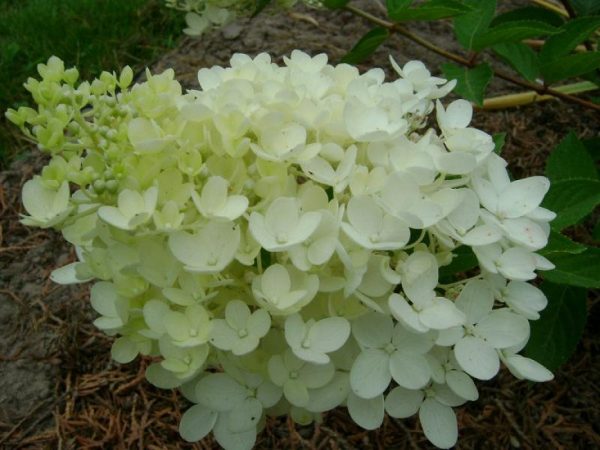
Hydrangea bombshell
Description of the variety
Hydrangea paniculata Bombshell (Latin Hydrangea paniculata Bombshell) is a deciduous shrub with a rounded compact crown.
The height of an adult specimen ranges from 70-100 cm, width - 90-120 cm.
For comparison, typical representatives of the paniculate subspecies grow up to 2-4 m. The leaves are pointed, ovoid, rather large (6-7 cm), with a pleasant intense green hue. The edges are serrated, by autumn they turn yellow and red.
It blooms for a long time - from July to September. Numerous sterile, star-shaped flowers with elliptical sepals form into large, dense cone-shaped inflorescences. At first, they are white, as they mature, they acquire a pink tint. Under them are hidden smaller fruiting flowers.
Strong, rigid stems keep the flower-stalks in an upright position without drooping.
Landing features
Panicle hydrangeas are generally unpretentious plants. But in order for them to reveal all the properties of the variety, it is necessary to fulfill a number of conditions.
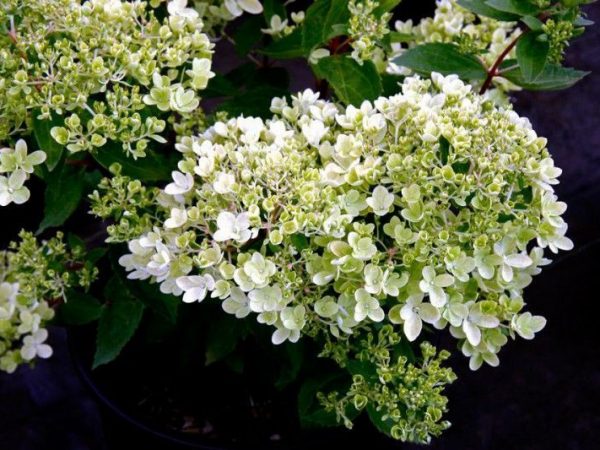
Hydrangea bombshell description and photo
Requirements for the soil: it must be acidic, loamy, fertile, while loose. There must be drainage under the horses.
Timing
Planting is possible throughout the growing season. Spring seedlings show the best growth results.
When planning an autumn planting, you need to finish one month before the first frost.
Preparatory work
Practice has shown that hydrangea grows better in light areas or in light partial shade.
In the shade, the plant also feels good, but the flowering intensity decreases significantly - up to single peduncles per bush. Before planting, the place is cleared of weeds (because they are carriers of diseases).
The seedlings should be healthy, have a developed root system without a hint of root rot. The good condition of the plant is indicated by strong elastic stems and a bright saturated color of the leaves, without spots, yellow areas, traces of rust and mold. The roots must be disinfected before planting.
Landing technology
They dig a fairly large hole - at least half a meter along three axes. Broken brick, expanded clay or other suitable material is placed at the bottom for drainage.
The plant is planted so that the ground does not cover the root collar. It must be watered with water to fill the underground voids around the roots with settling earth.
Care
It consists in annual pruning, weeding, mowing the lawn around the bushes, cleaning up the debris on the site so that slugs, snails and fungal infections do not spread.
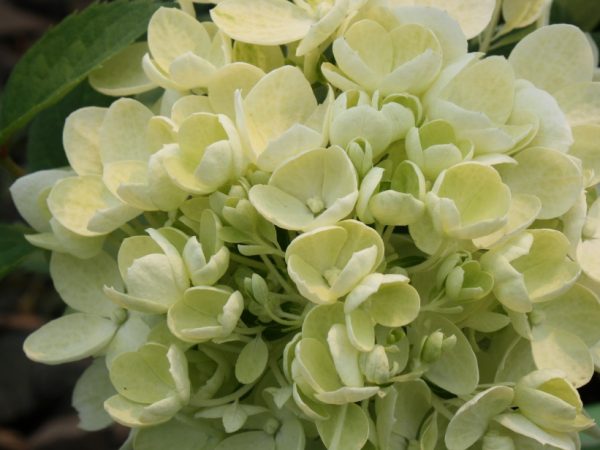
Hydrangea bombshell photo
Spring feeding with complex fertilizers will be a good help for hydrangeas.
Gardeners recommend regularly mulching the hole to retain moisture in the root zone.
Watering
If the soil is oily and loamy, while it rains regularly, additional watering is not required for an adult plant.
At the onset of the dry season, the state of the soil is monitored: if it has dried up by 3-4 cm, the hydrangea is watered (the calculation is 10-15 liters of water per bush).
Average. watering is carried out every 1-2 weeks. Young specimens (1-2 years old) more than others need a regular flow of moisture, especially in spring - at the beginning of the growing season. Root drip irrigation is preferable to top watering can or hose.
Top dressing
There are 2 main periods when hydrangea needs an influx of additional trace elements:
- Start growing season to pick up growth rate.
- The beginning of budding, so that the plant will please with abundant flowering.
They use different types of fertilizers. The most optimal in composition specialized store feed for hydrangeas. Also used are mixtures of urea, superphosphates and potassium salts.
Depending on the composition of the soil, you can additionally feed the mullein liquid infusion in July and August.
Attention! Mulching with organic elements - straw, hay, sawdust, needles, compost, rotted manure, peat - is also a top dressing.
Pruning
The procedure is necessary to give the bush a decorative shape, rejuvenation and thinning of plantings. It is carried out before winter or early spring.
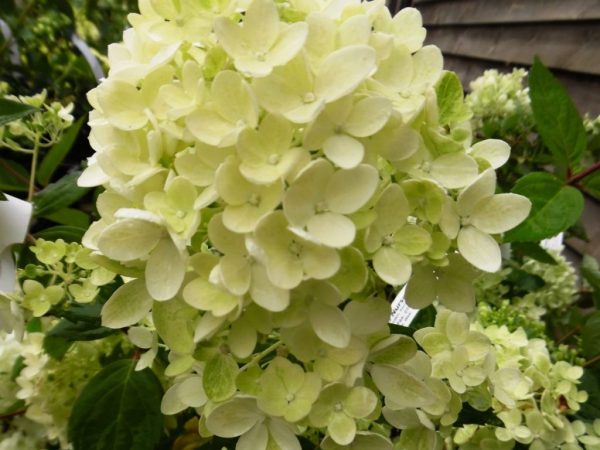
Hydrangea paniculata bombshell
It is best to do this in March, before the onset of swelling of the kidneys. Another option is during the period of foliage blooming with disinfection of the cut site.
Remove:
- frost-damaged, diseased, refined, crooked stems;
- branches growing inside the bush;
- root growth;
- extra side shoots.
To make the bush lush, with large, strong inflorescences, the old woody stems are cut from above into 2 buds, or half the length.
There is a technique when a certain number of skeletal branches (5-8) are left, and all other shoots are removed.
Preparing for winter
Panicle hydrangeas are one of the most winter-hardy in the Hortensia family. When grown in the southern and central regions, the upper part of the bush is usually not covered.
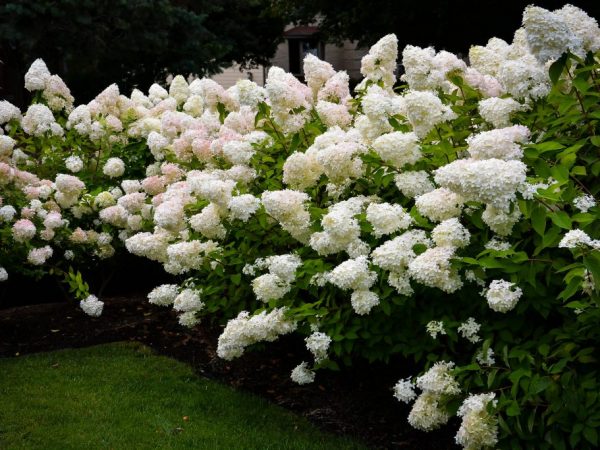
Hydrangea paniculata bombshell description:
They are limited to mulching the ground under the plant. Many advise to leave the dried panicles of inflorescences on the bush until spring for additional protection.
Reproduction
Cutting is the most preferable way of reproduction in domestic conditions of an elegant shrub.
The seed method is not practiced. First, the vast majority of flowers are sterile. Secondly, the seeds do not retain the distinctive qualities of the variety.
To grow a new bush, you need:
- Choose a young healthy shoot on an adult bush, step back 10-20 cm from the top and cut off the stalk.
- Tear off the lower pair of leaves - new roots grow faster from their sinuses. At least 2 pairs of green leaves should remain on top for photosynthesis.
- Put the cutting in a glass with a solution of "Kornevin" or another growth stimulator for a couple of hours.
- Dig into the ground 1/3 of its length. Some gardeners advise that the lower axils of the torn leaves be flush with the ground.
- Make a mini greenhouse from a film, a can, a plastic bottle.
- The hydrangea has large leaves. If they touch the walls of the greenhouse, they must be cut by 1/3 or half so that there is an air gap. Mold will appear on contact with damp walls, and the stalk may die.
- Ventilate the shelter every 1-2 days and check for mold.
Advice! Rooting usually occurs within 15-20 days. You can check by gently pulling on the upper edge of the handle. If resistance is felt, then reproduction was successful.
Diseases and pests
The variety has a strong immune system.It rarely gets sick, aphids and ticks on it are occasional guests. There is a weak predisposition to the following damaging factors.
| Problem | Decision | Prophylaxis |
| Bacterial wilting | Typical for the southern regions of Russia. In case of early symptoms, use Coronet. | Fight leaf beetles - the main vectors of the disease. Weed in time. |
| Rust | Destroy affected shoots and leaves. Treat with Fitosporin-M, Topaz, Ordan, Baktofit, Abiga-Peak. | Avoid excess nitrogen in the soil. Thin bushes by pruning. |
| Chlorosis | Feed with preparations containing iron and copper. Carry out acidification of the soil. Drizzle with a solution of ferrous sulfate. | Do not water with cold, unsettled, hard tap water. |
| Powdery mildew | Treat with "Fundazol", "Topaz", copper sulfate, Bordeaux liquid. | Do not overdo it with watering. Thin out thickets. Spray with iodine solution: 1 ml of pharmacy tincture per 1 liter of water. |
| Tracheomycosis (vascular wilting) | Poorly treatable fungal disease. At the initial stages, use "Fundazol", "Topsinom-M", "Vectra". | Do not use contaminated land. Before planting, treat with the fungicide "Maxim" |
Use in landscape design
Usually, they try to plant tall panicle hydrangea separately or next to other shrubs (lilac, bird cherry) or needles, the Bombshell variety is quite suitable for creating decorative compositions in a flower garden. Phloxes, hosts, astilba, delphinium, meadowsweet, aflatunsky onion, lupine, rudbeckia, goldenrod, spirea, rose bushes, New England asters look favorably against its background.
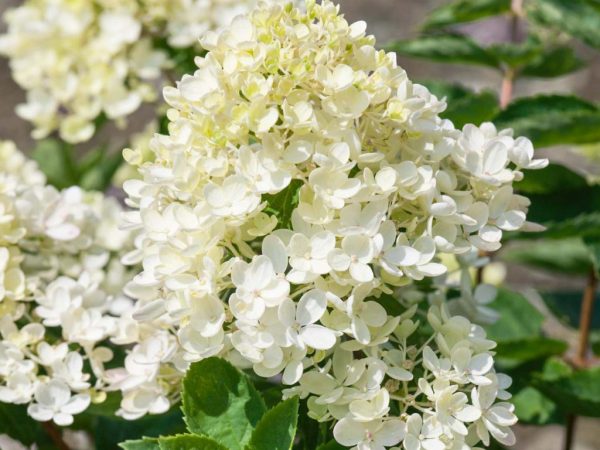
Bombshell panicle hydrangea
The culture is especially good in border plantings. It is in this capacity that it is most often grown. The relatively small size of the bush allows predicting the future shape and ideally choosing the distance between plants, avoiding both thickening and rarefaction.
Naturally, planting as a tapeworm in the middle of the lawn, or in tubs, remains relevant. In this case, nothing will overshadow the beauty of the hydrangea during the period of intense flowering. The cultivation of the Bombshell variety is practiced at home.
Gardeners reviews
The Bombshell variety is still gaining popularity among domestic florists. But in Europe he is well known and loved. It is also widespread in the United States.
Among its strengths, the owners note a beautiful appearance, winter hardiness, extremely abundant flowering, large flower panicle brushes, and disease resistance.
However, situations are not uncommon when there are few peduncles, while there is an abundance of green mass. An unpleasant effect arises after abnormal winters, or if the plant is grown in the shade. It also loses its rounded compact shape, if you do not engage in the formation of a bush, let its development take its course. Overall, Bombshell is an interesting new subspecies that overshadows most of the older varieties.

